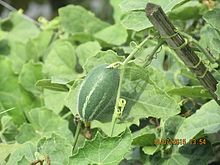Trichosanthes dioica
| Trichosanthes dioica | |
|---|---|

| |
| Scientific classification | |
| Kingdom: | |
| (unranked): | |
| (unranked): | |
| (unranked): | |
| Order: | |
| Family: | |
| Genus: | |
| Species: | T. dioica
|
| Binomial name | |
| Trichosanthes dioica | |

Trichosanthes dioica, also known as parval or pointed gourd,[1] is a vine plant in the Cucurbitaceae family, similar to cucumber and squash, though unlike those it is perennial. It is a dioecious (male and female plants) vine (creeper) plant with heart-shaped leaves (cordate) and is grown on a trellis. The fruits are green with white or no stripes. Size can vary from small and round to thick and long — 2 to 6 inches (5 to 15 cm). It thrives well under a hot to moderately warm and humid climate. The plant remains dormant during the winter season and prefers a fertile, well-drained sandy loam soil due to its susceptibility to water-logging.
Vernacular names
Trichosanthes dioica is known as:
- parwal or parval in Nepali, Hindi, and Gujarati
- kambupudalai in Tamil[2]
- kaadu padaval in Kannada
- potals in Telugu (especially in Northeastern Andhra)
- patolam in Malayalam
- potol in Sanskrit, Bengali (pôţol), and Assamese
- potala in Odia
- paror in Maithili
- parol in Magahi
- parora in Bhojpuri, Urdu, and Awadhi
India
Colloquially, in India, it is called parval or green potato. It is widely cultivated in the eastern and some northern parts of India, particularly in North eastern Andhra, Odisha, Bengal, Assam, Bihar, and Uttar Pradesh. It is used as an ingredient for soup, stew, curry, sweet, or eaten fried and as potoler dorma or dolma (dolma) with fish, roe or meat stuffing.
Bangladesh
Pointed gourd is provincially known as potol. It is a vital summer vegetable in Bangladesh. It is cultivated and consumed in every part of Bangladesh. It is a perennial crop and sold at the end of October when there is a shortage of other alternative vegetables.[3]
Nutrients
Pointed gourd is a good source of vitamins and minerals. It is a good source of carbohydrates, vitamin A, and vitamin C. It also contains major nutrients and trace elements (magnesium, potassium, copper, sulfur, and chlorine) which are needed in small quantities, for playing essential roles in human physiology. 9.0 mg Mg, 2.6 mg Na, 83.0 mg K, 1.1 mg Cu and 17 mg S per 100 g edible part.[3]
See also
References
- ^ USDA GRIN Taxonomy, retrieved 27 September 2015
- ^ Pointed Gourd Health Benefits, Usage – Ayurveda Details
- ^ a b Khatun, M; Malek, M. A.; Bari Miah, M. A.; Al-Amin, M.; Khanam, D. "In Vitro Regeneration In Pointed Gourd" (PDF). Bangladesh Research. Bangladesh Agricultural University. Retrieved 30 May 2015.
External links
- Article about parwal from Fort Valley State University College of Agriculture
